7 Millionth Visitor Day – Saturday 29 July
Drop in art and craft activity taking place throughout day – education room or meadow
10.30am - Ten Minute Tabby (Sue)
11.00am - Free guided walk around Haworth (Andrew)
11.45am - Ten Minute Tabby (Sue)
12.15pm - An Introduction to the Brontës (Ten minute talk by Andrew)
12.45pm - A Short History of Haworth Parsonage (Ten minute talk by Stephen)
1.30pm - Ann Cryer MP arriving
1.45pm - Branwell’s About (Andrew)
2.30pm - Ten Minute Tabby (Sue)
3.00pm - Peter Hill leader of Haworth Parish Council arriving
3.00pm - A Short History of Haworth Parsonage
3.20pm Branwell’s About (Andrew)
4.15pm - A Brontës’ Eye View (Ten minute talk by Andrew)
Bookmark this independent blog
Tuesday, 25 July 2006
Monday, 24 July 2006
What is taught, or not taught
Most of what follows here is based on a press release sent out last Friday. It gives an outline of my opinions on how classic literature is taught (or not taught) in English schools.
Because I am posting it, it seems inappropriate that it should be in the third person, so I have tweaked it a little.
Thanks for the emails so far received, incidentally (by way of hevelius@poriruacity.com) which are all more or less in tune, which is heartening and disappointing at the same time, because I was hoping to engage in a little back-and-forth.
For the benefit of a couple of American correspondents, I must state that I know precious little about the curriculum in the high schools there, so I’ll leave it up to the locals to find similarities and differences and to pass judgement.
Please note the sentence - This is often in spite of the best efforts of teachers. I happen to know some excellent ones, who find ways round officially prescribed practices and who plant seeds.
I am aware that in the last couple of years, a number of well-informed teachers and advisers have deplored the lack of real “opportunities for extended reading” in the curriculum, so there are moves to correct imbalances, but this usually involves currently-practising authors like David Almond, whose brilliant novel Clay features strongly in the Carnegie Shadowing Project .
This is a nationwide reading challenge where students read five books that have been on the shortlist for the Carnegie medal. The official website is at www.carnegiegreenaway.org.uk
So, I think that:
Young people are given insufficient time in the classroom for in-depth study of texts. This is often in spite of the best efforts of teachers.
Many more people are drawn towards the Brontës by forces outside schools, for example by new adaptations of novels like Jane Eyre by the BBC.
A series of Government initiatives in schools - with the admirable objective of improving standards of literacy - has led to a situation in which love of reading and literature generally is being rather neglected in favour of a rigid 'framework' approach.
For at least the last decade the definition of English as a subject has been increasingly prescribed. The emphasis on capital L Literacy is becoming a significant encroachment on English as a creative and humanistic domain, because it does not appear to give more than a token acknowledgement for the value of literature.
I believe in the sharing of 'real' texts, whether described as classic or popular. This enables personal growth and the study of literature to come together. This sharing - through reading, creative writing and improvised drama - was the feature of the Brontë children's early educational experiences which led to the great works which followed later.
The forces which drove them in a nineteenth century parsonage are universal, and can be harnessed in many other environments including that of a twenty-first century classroom.
Currently-prescribed practices in the official literacy strategy require pupils to focus on fragments of text, seldom on whole texts which might elicit a 'whole' response. This discourages the formation of a profound personal relationship with a work of literature.
The best teaching is based on the stimulation of the imagination, of course, and teachers can get plenty of advice on that from the Parsonage, which is rapidly developing into a regional centre for the Arts.
Richard Wilcocks
Chairman of Council
Because I am posting it, it seems inappropriate that it should be in the third person, so I have tweaked it a little.
Thanks for the emails so far received, incidentally (by way of hevelius@poriruacity.com) which are all more or less in tune, which is heartening and disappointing at the same time, because I was hoping to engage in a little back-and-forth.
For the benefit of a couple of American correspondents, I must state that I know precious little about the curriculum in the high schools there, so I’ll leave it up to the locals to find similarities and differences and to pass judgement.
Please note the sentence - This is often in spite of the best efforts of teachers. I happen to know some excellent ones, who find ways round officially prescribed practices and who plant seeds.
I am aware that in the last couple of years, a number of well-informed teachers and advisers have deplored the lack of real “opportunities for extended reading” in the curriculum, so there are moves to correct imbalances, but this usually involves currently-practising authors like David Almond, whose brilliant novel Clay features strongly in the Carnegie Shadowing Project .
This is a nationwide reading challenge where students read five books that have been on the shortlist for the Carnegie medal. The official website is at www.carnegiegreenaway.org.uk
So, I think that:
Young people are given insufficient time in the classroom for in-depth study of texts. This is often in spite of the best efforts of teachers.
Many more people are drawn towards the Brontës by forces outside schools, for example by new adaptations of novels like Jane Eyre by the BBC.
A series of Government initiatives in schools - with the admirable objective of improving standards of literacy - has led to a situation in which love of reading and literature generally is being rather neglected in favour of a rigid 'framework' approach.
For at least the last decade the definition of English as a subject has been increasingly prescribed. The emphasis on capital L Literacy is becoming a significant encroachment on English as a creative and humanistic domain, because it does not appear to give more than a token acknowledgement for the value of literature.
I believe in the sharing of 'real' texts, whether described as classic or popular. This enables personal growth and the study of literature to come together. This sharing - through reading, creative writing and improvised drama - was the feature of the Brontë children's early educational experiences which led to the great works which followed later.
The forces which drove them in a nineteenth century parsonage are universal, and can be harnessed in many other environments including that of a twenty-first century classroom.
Currently-prescribed practices in the official literacy strategy require pupils to focus on fragments of text, seldom on whole texts which might elicit a 'whole' response. This discourages the formation of a profound personal relationship with a work of literature.
The best teaching is based on the stimulation of the imagination, of course, and teachers can get plenty of advice on that from the Parsonage, which is rapidly developing into a regional centre for the Arts.
Richard Wilcocks
Chairman of Council
Friday, 21 July 2006
Seven Millionth Celebration

Parsonage Museum director Alan Bentley is seen here with retired toxicologist Derek Stringer and his wife Nancy, from Bowness-on-Windermere, both 73. They were the seven millionth visitors to the Parsonage, in June.
Mr Stringer, who had never even opened any of the Brontë novels before being presented with a ‘goody bag’ containing all of them, has now been stimulated into starting Wuthering Heights.
The Stringers have also been given a year’s free membership of the Brontë Society, and have been invited to be guests of honour at the Parsonage open day next Saturday, July 29th.
The highest number of visitors ever recorded at the museum since it opened in 1928 was 221,000 in 1974. The figure was attributed at the time to the popularity of the TV series, The Brontës of Haworth, and the recent success of the Wuthering Heights film starring Anna Calder-Marshall and Timothy Dalton.
Soon after, it was decided that the large numbers of visitors were damaging the 200 year-old building and the numbers were regulated. Now the museum sees about 88,000 visitors a year.
"It's my wife who is the Brontë fan,” Mr Stringer said. “She has read all the novels.
"We went because, of course, we are aware of the Brontë heritage and the importance of them in English literature. We also wanted to see the environment in which the books were written."
It was their first visit, and they were surprised to learn they were the seven millionth.
Next Saturday’s open day will be free to people living in postcode areas BD20, BD21 and BD22. Identification will be required.
The day will include a dramatic interpretation, free guided walks around Haworth and short talks on the Brontës. Here is the timetable:
Throughout the day - in the education room or the meadow - drop in art and craft activity.
10.30am - Ten Minute Tabby (Sue Newby)
11.00am - Free guided walk around Haworth (Andrew McCarthy)
11.45am - Ten Minute Tabby (Sue Newby)
12.15pm - An Introduction to the Brontës (Ten minute talk by Andrew McCarthy)
12.45pm - A Short History of Haworth Parsonage (Ten minute talk by Stephen Whitehead)
1.45pm - Branwell's About (Andrew McCarthy)
2.30pm - Ten Minute Tabby (Sue Newby)
3.00pm - A Short History of Haworth Parsonage
3.20pm - Branwell's About (Andrew McCarthy)
4.15pm - A Brontës' Eye View (Ten minute talk by Andrew McCarthy)
Monday, 17 July 2006
Cornelia Parker Exhibition
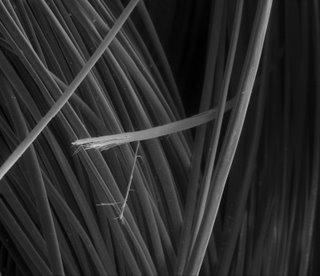
Sample of Anne's hair
The Cornelia Parker Exhibition launches the Brontë Contemporary Arts Programme.
An ambitious project to establish the Brontë Parsonage Museum in Haworth as a vibrant centre for the creative arts will be officially launched with a stunning new exhibition by one of Britain's most famous artists, and Turner Prize nominee, Cornelia Parker.
Cornelia Parker's Brontëan Abstracts exhibition will run from Saturday 16 September to Sunday 31 December 2006 and will, most unusually, be displayed within period rooms of the Parsonage. Cornelia has been working with the Museum over the past year developing new work which will offer visitors a unique opportunity to see the Brontës interpreted through the work of a major contemporary British artist.
She has been exploring the Museum's collection, viewing original Brontë manuscripts in the British Library and working with the University of Bradford analysing samples of Brontë hair, using electron microscope imaging technology. The exhibition will include a series of images of Brontë artefacts, including samples of hair produced using this method.
“By capturing images of the Brontës' relics through a microscope,” she explained, “I have been using the tools of science to try to understand the power of the myth. Whether it is a split end of Anne's hair or pinholes made by Charlotte or the tines of a comb burnt by Emily, they are abstractions made by them, unconsciously.”
The Brontë Parsonage Museum has, over the years, attracted international artists, authors and film-makers all keen to interpret the lives of one of the most famous literary families of all time. The Museum is seeking to use the historic home of the Brontës in a new and dynamic way to bring the collections to life for visitors and make new connections with the creative arts.
Andrew McCarthy, Parsonage Deputy Director, said, “Exhibiting work by such a prominent artist is very exciting and an historic opportunity for the Museum.
“Cornelia Parker is interested in people, places and objects which have become so established within public consciousness as to have taken on a monumental quality. This is certainly true of the Brontës.
“The problem with monuments is that they can become caricatures and Brontëan Abstracts will challenge some of our preconceptions about the Brontës and give us a new perspective on them”.
The exhibition was made possible with support from Illuminate, The Esmée Fairburn Foundation and The Henry Moore Foundation. The Illuminate festival is a programme of arts and cultural events taking place in the five Yorkshire cities of Bradford, Hull, Leeds, Sheffield and York from October 2005 to October 2006 and has been funded by the DCMS.
The Parsonage will be contributing to the festival with a week-long programme of Brontë events from Saturday 16 September 2006 to Sunday 24 September 2006.
The Parsonage Contemporary Arts Programme, which has Professor Germaine Greer as Honorary Patron, will include visual arts, theatre, music, poetry, talks and workshops involving visiting authors, and more Please see the Parsonage website for further information - www.bronte.info
This media release is from Diane Benn
Cornelia Parker Biography
Cornelia Parker was born in Cheshire in 1956 and lives and works in London. She studied at Gloucestershire College of Art and Design, Wolverhampton Polytechnic and at Reading University.
She is best known for a number of large-scale installations including Cold Dark Matter: An Exploded View (1991), and The Maybe (1995), a collaboration with actress Tilda Swinton, who appeared sleeping inside a vitrine at the Serpentine Gallery.
In tandem with large projects like these she has also made an ongoing series of smaller works entitled Avoided Object, working in collaboration with numerous institutions including HM Customs & Excise, The Royal Armouries and Madame Tussauds.
In 1997 she was awarded a residency at ArtPace in San Antonio, Texas and was shortlisted for the Turner Prize, Tate Gallery, London. In 1998 she had major solo exhibitions at the Serpentine Gallery, London, and Deitch Projects, New York. A retrospective of her work was held at the ICA Boston in 2000. In 2001, the Galeria de Arte Moderne in Turin presented a major one-person show, and the Victoria & Albert Museum in London commissioned a permanent installation for the British Galleries.
Recent group exhibitions include The Tate Triennale, Tate Britain 2003 and The Disembodied Spirit, Bowdoin Museum of Art, USA. She has works in the Tate Collection and in numerous public and private collections in Europe and the USA. She is represented by Frith Street Gallery, London.
Sunday, 9 July 2006
Wide Sargasso Sea
A BBC FOUR news release, received yesterday, reveals the following:
Wide Sargasso Sea adapted for BBC FOUR this Autumn
Rafe Spall, Rebecca Hall and Nina Sosanya head up the cast in an adaptation of Wide Sargasso Sea, Jean Rhys' highly-charged prequel to Jane Eyre by Charlotte Brontë, by the makers of Spooks and Life on Mars.
Set in the lush landscape of Jamaica after the emancipation of slaves, Wide Sargasso Sea tells the story of the arranged marriage between a white Creole heiress and an Englishman (see below)
Rhys, herself a Creole, felt Brontë had misrepresented Creole women in her work. She wanted to show an alternative to the story of Bertha Mason, Mr Rochester's first wife, and dispel the 'mad wife' image created by Bronte.
Rhys' powerful work describes not only the meltdown of lust and passion, but also the atmosphere of paranoia and racial tensions that characterised the Caribbean in the 1830s.
The film stars Rafe Spall (The Chatterley Affair) as Edward; Rebecca Hall, appearing in Christopher Nolan's new film The Prestige this Autumn, plays his wife Antoinette Cosway; Nina Sosanya (Casanova) plays her nurse Christophine; Michael Maloney plays Mr Mason; Victoria Hamilton plays Cora; and Katrine de Candole plays Annette.
BBC FOUR Controller Janice Hadlow said: "It's great that Jean Rhys' captivating prequel to Jane Eyre is being adapted for BBC FOUR and with such a fantastic cast."
Claire Parker, Co-Executive Producer, said: "Stephen Greenhorn's wonderful script and Brendan Maher's fresh, original direction have attracted a fantastic cast to the project, from exciting, young, emerging talent such as Rafe Spall and Rebecca Hall, to established names such as Nina Sosanya, Victoria Hamilton and Michael Maloney.
"We are delighted to have the opportunity to bring to the screen Jean Rhys' passionate story of the first Mrs Rochester.
"This is period drama with a twist – contemporary and compelling."
Filming for Wide Sargasso Sea is currently underway in Jamaica and in locations around the UK.
The film is a Kudos Film and Television production and
is adapted by Stephen Greenhorn, who has written extensively for the stage and television.

Jean Rhys
The novel
James Fox adds:
Wide Sargasso Sea by Jean Rhys (new edition published by Penguin in 1997)
This is the story (first published in 1966) of Bertha, Rochester’s first bride. The novel gives us a new slant on the Brontë classic and a damning observation of colonialism in the West Indies. It is set just after the slaves have been emancipated, when race relations are tense. Rochester knows the woman whom he later calls Bertha (it’s her middle name) as Antoinette. She is descended from once-rich plantation owners, and has a number of half brothers and sisters, the result of her father’s relationships with various black women.
She is a “white creole� with a taint, at the time scandalous, of “racial impurity�. In addition, there is a suspicion of mental instability, so she is not accepted by either the local black community or by the white colonial establishment.
Rhys makes it clear that alternative voices have been suppressed in Jane Eyre : here, Rochester and Antoinette have the speaking voice divided between them, although Rochester is never actually named. He is portrayed as a younger brother full of pride and prejudice who is lured into a marriage without love by his unscrupulous family. He accuses Antoinette of being promiscuously attracted towards black people - but he has no qualms about making love with the maid Amelie, so revealing his hypocrisy with regard to former slaves. Briefly, he is happy at Granbois, but he readily believes the worst about his wife, and everything falls apart.
Jean Rhys can not change the essentials of the Brontë text, but she does allow us to see the events from a new angle, and leaves the ending open. Antoinette dreams of the fire and her death-leap but the novel ends with her resolve to do something. Irony indeed!
Wide Sargasso Sea adapted for BBC FOUR this Autumn
Rafe Spall, Rebecca Hall and Nina Sosanya head up the cast in an adaptation of Wide Sargasso Sea, Jean Rhys' highly-charged prequel to Jane Eyre by Charlotte Brontë, by the makers of Spooks and Life on Mars.
Set in the lush landscape of Jamaica after the emancipation of slaves, Wide Sargasso Sea tells the story of the arranged marriage between a white Creole heiress and an Englishman (see below)
Rhys, herself a Creole, felt Brontë had misrepresented Creole women in her work. She wanted to show an alternative to the story of Bertha Mason, Mr Rochester's first wife, and dispel the 'mad wife' image created by Bronte.
Rhys' powerful work describes not only the meltdown of lust and passion, but also the atmosphere of paranoia and racial tensions that characterised the Caribbean in the 1830s.
The film stars Rafe Spall (The Chatterley Affair) as Edward; Rebecca Hall, appearing in Christopher Nolan's new film The Prestige this Autumn, plays his wife Antoinette Cosway; Nina Sosanya (Casanova) plays her nurse Christophine; Michael Maloney plays Mr Mason; Victoria Hamilton plays Cora; and Katrine de Candole plays Annette.
BBC FOUR Controller Janice Hadlow said: "It's great that Jean Rhys' captivating prequel to Jane Eyre is being adapted for BBC FOUR and with such a fantastic cast."
Claire Parker, Co-Executive Producer, said: "Stephen Greenhorn's wonderful script and Brendan Maher's fresh, original direction have attracted a fantastic cast to the project, from exciting, young, emerging talent such as Rafe Spall and Rebecca Hall, to established names such as Nina Sosanya, Victoria Hamilton and Michael Maloney.
"We are delighted to have the opportunity to bring to the screen Jean Rhys' passionate story of the first Mrs Rochester.
"This is period drama with a twist – contemporary and compelling."
Filming for Wide Sargasso Sea is currently underway in Jamaica and in locations around the UK.
The film is a Kudos Film and Television production and
is adapted by Stephen Greenhorn, who has written extensively for the stage and television.

Jean Rhys
The novel
James Fox adds:
Wide Sargasso Sea by Jean Rhys (new edition published by Penguin in 1997)
This is the story (first published in 1966) of Bertha, Rochester’s first bride. The novel gives us a new slant on the Brontë classic and a damning observation of colonialism in the West Indies. It is set just after the slaves have been emancipated, when race relations are tense. Rochester knows the woman whom he later calls Bertha (it’s her middle name) as Antoinette. She is descended from once-rich plantation owners, and has a number of half brothers and sisters, the result of her father’s relationships with various black women.
She is a “white creole� with a taint, at the time scandalous, of “racial impurity�. In addition, there is a suspicion of mental instability, so she is not accepted by either the local black community or by the white colonial establishment.
Rhys makes it clear that alternative voices have been suppressed in Jane Eyre : here, Rochester and Antoinette have the speaking voice divided between them, although Rochester is never actually named. He is portrayed as a younger brother full of pride and prejudice who is lured into a marriage without love by his unscrupulous family. He accuses Antoinette of being promiscuously attracted towards black people - but he has no qualms about making love with the maid Amelie, so revealing his hypocrisy with regard to former slaves. Briefly, he is happy at Granbois, but he readily believes the worst about his wife, and everything falls apart.
Jean Rhys can not change the essentials of the Brontë text, but she does allow us to see the events from a new angle, and leaves the ending open. Antoinette dreams of the fire and her death-leap but the novel ends with her resolve to do something. Irony indeed!
Jenny Beavan in Italy
Sant’Agata dei Goti is a charming medieval village in Campania, a region of Southern Italy where the Sannio Film Festival is held every year in July.
It is the only European festival entirely dedicated to costume films and this year on Thursday 6th July it payed a particular homage to Jenny Beavan, one of the greatest costume designers of the world and the creator of costumes for films like Gosford Park, Sense and Sensibility, Howard’s End, Alexander and in particular Zeffirelli’s Jane Eyre.
Jane and Rochester’s wedding dresses were on show along with all the others in a splendid exhibition in a church dedicated to Saint Francis.
Since Sant’Agata dei Goti is a three hundred kilometres drive from where I live, as a representative of the Brontë Society as well as the Italian member of the editorial board of Brontë Studies, on the fixed day I hurried there to meet the famous Oscar winning lady and to congratulate her for her Brontë-related work.
The organisers of the Sannio Film Festival on their part had already planned to give her a special award for her career and to project Zeffirelli’s film on to a large screen in the afternoon while I was waiting Ms. Beavan’s arrival, so I enjoyed watching it on the Mustilli holiday farm.
Ms. Beavan was then welcomed in a little square in the crowded centre of Sant'Agata. She was led from there to her costumes exhibition.
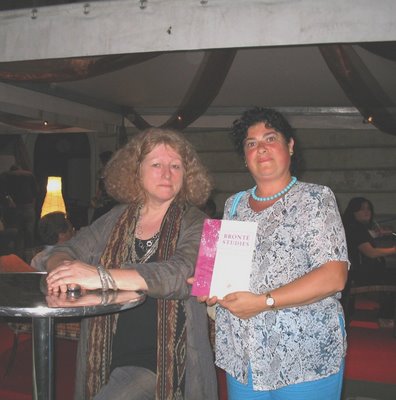
A friendly and talkative lady, Jenny walked all the way with some other film directors and costume designers (notably the one for Oliver Twist) and was very much photographed.
I had the opportunity to take some photos and have a chat with her and of course I asked about her work for Jane Eyre. She told me she had realized all of it in only six weeks and on location during the film making, this being always her work technique. In any case she usually keeps all ideas in her mind, writing just a few notes on a scrap of paper on the director’s directions and tastes. Then I asked Jenny if she already knew Mr Zeffirelli at the time and she answered that she didn’t, he had simply phoned her after examining her previous work.

The evening in Sant’Agata dei Goti was for me a wonderful occasion to meet once more a gifted and sensitive woman but also the best way to let our Society be known to her and to the Italian people present there.
Maddalena De Leo
It is the only European festival entirely dedicated to costume films and this year on Thursday 6th July it payed a particular homage to Jenny Beavan, one of the greatest costume designers of the world and the creator of costumes for films like Gosford Park, Sense and Sensibility, Howard’s End, Alexander and in particular Zeffirelli’s Jane Eyre.
Jane and Rochester’s wedding dresses were on show along with all the others in a splendid exhibition in a church dedicated to Saint Francis.
Since Sant’Agata dei Goti is a three hundred kilometres drive from where I live, as a representative of the Brontë Society as well as the Italian member of the editorial board of Brontë Studies, on the fixed day I hurried there to meet the famous Oscar winning lady and to congratulate her for her Brontë-related work.
The organisers of the Sannio Film Festival on their part had already planned to give her a special award for her career and to project Zeffirelli’s film on to a large screen in the afternoon while I was waiting Ms. Beavan’s arrival, so I enjoyed watching it on the Mustilli holiday farm.
Ms. Beavan was then welcomed in a little square in the crowded centre of Sant'Agata. She was led from there to her costumes exhibition.

A friendly and talkative lady, Jenny walked all the way with some other film directors and costume designers (notably the one for Oliver Twist) and was very much photographed.
I had the opportunity to take some photos and have a chat with her and of course I asked about her work for Jane Eyre. She told me she had realized all of it in only six weeks and on location during the film making, this being always her work technique. In any case she usually keeps all ideas in her mind, writing just a few notes on a scrap of paper on the director’s directions and tastes. Then I asked Jenny if she already knew Mr Zeffirelli at the time and she answered that she didn’t, he had simply phoned her after examining her previous work.

The evening in Sant’Agata dei Goti was for me a wonderful occasion to meet once more a gifted and sensitive woman but also the best way to let our Society be known to her and to the Italian people present there.
Maddalena De Leo
Tuesday, 4 July 2006
Annual June Weekend
Every year, members of the Brontë Society gather in Haworth in the first week of June for a series of entertainments and events. This selection of photographs should give a flavour of what went on.
On the Friday evening, the Live Literature Company performed Charlotte, Emily and Anne by Douglas Verrall, directed by Valerie Doulton. The company was launched in October 2002 with Byron in Love, which was performed in the room in Melbourne House, Whitehall, where Byron met Lady Caroline Lamb, and has since gone from strength to strength.
Charlotte, Emily and Anne was performed in the West Lane Baptist Church in Haworth.

From the left Karen Lomas (Anne Brontë), Anna Calder-Marshall (Emily Brontë) and Catherine Harvey (Charlotte Brontë)
Anna Calder-Marshall later spoke about her famous role as Cathy in Wuthering Heights alongside Timothy Dalton's Heathcliff, and about her highly emotional re-encounter with the Brontë Parsonage Museum earlier in the day.
Anna has worked many times with Valerie Doulton on William Blake programmes. Recent works include Lie of the Land at The Donmar, Birthday Party and Bird Calls at Sheffield Crucible, Humble Boy in the West End and her one woman show The Wild Girl.

Brontë Society President Rebecca Fraser speaks to Valerie Doulton after the performance.
On the Saturday, Dudley Green delivered a lecture based on his recently-published The Letters of the Reverend Patrick Brontë, which is available online from the Parsonage shop. He read a number of the letters and made the point that Patrick was a highly eloquent, energetic and sometimes contradictory character, a compassionate campaigner whose letters often appeared in such newspapers as The Leeds Intelligencer and its rival, The Leeds Mercury. He could sound very radical and 'modern' in his opposition to the Poor Law Amendment Act, even at one point describing the workhouses as 'Bastilles' (a term used by some of the Chartists) and also conventionally 'old-fashioned' in his defence of the dominance of the Church of England.

Dudley Green
Later on the Saturday, Justine Picardie talked about My Mother's Wedding Dress, her 'memoir of frocks worn by the Picardie family' in the words of Independent columnist Vera Rule - who goes on:
It's even more an inventory of sartorial loss - solitary socks and wedding dresses that disappeared through what Picardie laments as misfortune but sounds more like carelessness. And all draped around the central loss of her life, the death of her sister Ruth, which made Picardie contemplate the darkness at the heart of wardrobes: the serial little deaths and resurrections of fashion; the garments left behind, personalised by amendment and wear (the button resewn to the Gap jacket with unmatching thread) that sadden us as they hang there, carapaces for who we were or those we cared about.
The whole of Vera Rule's review can be found at http://enjoyment.independent.co.uk/books/reviews/article313161.ece
Her talk also included comments on the works of Daphne du Maurier in general and her The Infernal World of Branwell Brontë in particular. This has recently been republished with a preface by Justine Picardie.
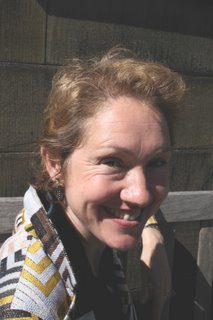
Justine Picardie
On the Sunday, there were walks and a brass band concert. Excursions and visits to Manchester and Kirk Smeaton (once home for Arthur Bell Nicholls) took place on Monday and Tuesday - photos will be posted when available.
On the Friday evening, the Live Literature Company performed Charlotte, Emily and Anne by Douglas Verrall, directed by Valerie Doulton. The company was launched in October 2002 with Byron in Love, which was performed in the room in Melbourne House, Whitehall, where Byron met Lady Caroline Lamb, and has since gone from strength to strength.
Charlotte, Emily and Anne was performed in the West Lane Baptist Church in Haworth.

From the left Karen Lomas (Anne Brontë), Anna Calder-Marshall (Emily Brontë) and Catherine Harvey (Charlotte Brontë)
Anna Calder-Marshall later spoke about her famous role as Cathy in Wuthering Heights alongside Timothy Dalton's Heathcliff, and about her highly emotional re-encounter with the Brontë Parsonage Museum earlier in the day.
Anna has worked many times with Valerie Doulton on William Blake programmes. Recent works include Lie of the Land at The Donmar, Birthday Party and Bird Calls at Sheffield Crucible, Humble Boy in the West End and her one woman show The Wild Girl.

Brontë Society President Rebecca Fraser speaks to Valerie Doulton after the performance.
On the Saturday, Dudley Green delivered a lecture based on his recently-published The Letters of the Reverend Patrick Brontë, which is available online from the Parsonage shop. He read a number of the letters and made the point that Patrick was a highly eloquent, energetic and sometimes contradictory character, a compassionate campaigner whose letters often appeared in such newspapers as The Leeds Intelligencer and its rival, The Leeds Mercury. He could sound very radical and 'modern' in his opposition to the Poor Law Amendment Act, even at one point describing the workhouses as 'Bastilles' (a term used by some of the Chartists) and also conventionally 'old-fashioned' in his defence of the dominance of the Church of England.

Dudley Green
Later on the Saturday, Justine Picardie talked about My Mother's Wedding Dress, her 'memoir of frocks worn by the Picardie family' in the words of Independent columnist Vera Rule - who goes on:
It's even more an inventory of sartorial loss - solitary socks and wedding dresses that disappeared through what Picardie laments as misfortune but sounds more like carelessness. And all draped around the central loss of her life, the death of her sister Ruth, which made Picardie contemplate the darkness at the heart of wardrobes: the serial little deaths and resurrections of fashion; the garments left behind, personalised by amendment and wear (the button resewn to the Gap jacket with unmatching thread) that sadden us as they hang there, carapaces for who we were or those we cared about.
The whole of Vera Rule's review can be found at http://enjoyment.independent.co.uk/books/reviews/article313161.ece
Her talk also included comments on the works of Daphne du Maurier in general and her The Infernal World of Branwell Brontë in particular. This has recently been republished with a preface by Justine Picardie.

Justine Picardie
On the Sunday, there were walks and a brass band concert. Excursions and visits to Manchester and Kirk Smeaton (once home for Arthur Bell Nicholls) took place on Monday and Tuesday - photos will be posted when available.
Wednesday, 7 June 2006
Meeting in Vignola

Prof. Franca Gollini Tiezzi reports on a recent meeting of the Italian Section:
On 27th May 2006 we met in Vignola at the Osteria della Luna, an old and historic inn in the very centre of the town, not far from the medieval castle.
The meeting was to celebrate the reprinting of the Italian
translation of The Life of Charlotte Brontë by Elizabeth Gaskell.
After introducing the famous book, Prof. Franca Musi read some of the most significant letters which Patrick Brontë wrote to Mrs Gaskell asking her to write the memoir of his dear daughter Charlotte immediately after her death. The letters were taken from The Letters of the Reverend Patrick Brontë edited by Dudley Green. They give us a new picture of the Brontës' father who is seen for the first time not only as an eccentric but also as a learned, sensitive, caring man.
The talk aroused great interest and enthusiasm and was followed by a lot of questions about Patrick and the Brontës.
The meeting ended with a nice party with delicious cakes and the famous Vignola cherries.

Friday, 2 June 2006
Thanks for voting for us
Viewers of BBC2’s People’s Museum programme voted in their hundreds on 30 May to ensure that an early ‘little book’ written by Charlotte Brontë would be included in an on-line People’s Museum.
Although the Enigma Machine, which was invented by the Germans in 1918 solely to encipher and decipher messages, was the overall winner on the day, the little book' came a close second with 958 votes - one of the highest scores awarded to a single object throughout the programme.
A source at Reef TV who produced the programme said “Charlotte’s little book generated hundreds of viewers' votes, much more than some of the other objects up for election. The Enigma Machine received 1,631 votes on the day so Charlotte’s book was unfortunately pipped at the post for the top place�.
The People’s Museum programme has invited viewers to vote on their favourite museum artefact from across the UK. The object with the most votes will be proclaimed the overall winner on 9 June 2006. Items which have been voted for by the public will be placed in a virtual People’s Museum hosted on the BBC’s history website
TV Presenter Jules Hudson, who is an historian, an archaeologist and the presenter of Channel 4’s Time Team and the BBC’s Horizon programmes described the book as “an incredibly small but important relic that so innocently maps out the beginnings of an extraordinarily talented woman’s life".
Polly Salter, Curator at the Brontë Parsonage Museum added, “We are delighted that Charlotte’s book received so many votes. The little book is rarely out on display at the museum due to its delicate nature, but with increased interest from visitors we have agreed to exhibit the book for the rest of the year for all to see�.
This post is from Diane Benn
Although the Enigma Machine, which was invented by the Germans in 1918 solely to encipher and decipher messages, was the overall winner on the day, the little book' came a close second with 958 votes - one of the highest scores awarded to a single object throughout the programme.
A source at Reef TV who produced the programme said “Charlotte’s little book generated hundreds of viewers' votes, much more than some of the other objects up for election. The Enigma Machine received 1,631 votes on the day so Charlotte’s book was unfortunately pipped at the post for the top place�.
The People’s Museum programme has invited viewers to vote on their favourite museum artefact from across the UK. The object with the most votes will be proclaimed the overall winner on 9 June 2006. Items which have been voted for by the public will be placed in a virtual People’s Museum hosted on the BBC’s history website
TV Presenter Jules Hudson, who is an historian, an archaeologist and the presenter of Channel 4’s Time Team and the BBC’s Horizon programmes described the book as “an incredibly small but important relic that so innocently maps out the beginnings of an extraordinarily talented woman’s life".
Polly Salter, Curator at the Brontë Parsonage Museum added, “We are delighted that Charlotte’s book received so many votes. The little book is rarely out on display at the museum due to its delicate nature, but with increased interest from visitors we have agreed to exhibit the book for the rest of the year for all to see�.
This post is from Diane Benn
Wednesday, 31 May 2006
Can you see them?

Several people have been in contact recently saying that they can see only the articles and pictures on their screens - not the links and the archive which should be displayed on the right hand side. The same people then reveal that their only browser is a version of Internet Explorer.
The right hand side appears to be shown on some versions of Explorer though. The blog is set up on a Mac using either Safari or Firefox. Safari is standard on many Macs, but Firefox is available for PCs.
It is possible to update your older version of Explorer, but be careful: it is sometimes described as a 'Swiss cheese' of a browser which has in the past let in viruses and hackers with ease and which is still vulnerable in spite of all the latest spin from Microsoft. Why not switch to something else (for free) like Mozilla-Firefox?
Please feel free to discuss your technical problems by emailing heveliusx1@yahoo.co.uk You won't be able to see this contact address if you can't see the right hand side.
Saturday, 20 May 2006
Shirley Country Guide
Richard Wilcocks writes:
On Friday 19 May Kirklees Community History and Kirklees Tourism launched the Shirley Country Guide. To be strictly accurate, they relaunched it in a splendid new colour version, because it has appeared in a shorter form before.
Shirley Country is the name generally accepted by both the Brontë Society and Kirklees Metropolitan Council as the name for the area of West Yorkshire crossed by the River Spen and the manically busy M62 motorway which contains such havens of leafy tranquillity as the Red House in Gomersal, Oakwell Hall in Birstall and St Peter's Church in Hartshead, an area well known to Charlotte Brontë, Ellen Nussey, Mary Taylor and many of the real-life characters who appeared with fictional names in Shirley.
Published in 1849, the novel caused quite a sensation. The local literate, gossiping classes had only just discovered that the quiet parson's daughter from Haworth was secretly the famous Currer Bell, the author of Jane Eyre. Now they found themselves and their neighbours appearing in her latest work.
Charlotte knew the area well from her schooldays in Mirfield and was a frequent visitor. When Charlottë's parents were first married they lived in Hightown, and her father was minister at Hartshead at the time of the Luddite riots of 1812.
The guide features information, directions to and a map of fourteen places which Charlotte knew. Visitors are invited to create their own literary trail.
Some locations have actually disappeared - Rawfold's Mill, for example, which once held out against hundreds of armed and masked Luddites - most of them skilled workers intent on smashing up the new machinery inside which had taken away their livelihoods. It is now a corner of a modern industrial estate.
Oakwell Hall, on the other hand, is thriving in its hundred acres of idyllic parkland rolling down to the edge of the M62, an Elizabethan manor house which contains many of the features of Fieldhead, as described by Charlotte in Shirley, with a visitors' centre nearby geared to the needs of school parties.
The launch started here. Several dozen guests - including representatives of the Brontë Society - watched Charlotte (played by Tania Gillmartin) and Ellen (Bridgid Harbour) arrive by horse-drawn carriage, to be met by the Mayor of Kirklees, Councillor Margaret Fearnley. Joanne Catlow as Shirley Keeldar confronted Chris Yates as the Curate Mr Donne as part of a dramatised extract from the novel performed in the dark-panelled main hall inside.
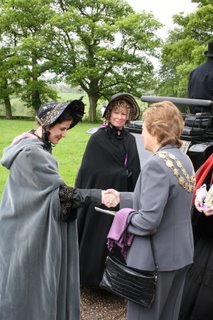
Charlotte and Ellen later travelled by horse-drawn carriage to Briarmains - Red House. The guests went by a more modern coach.

At Briarmains, Mary Taylor (Julie O'Connell) did the greeting, and snifters of madeira wine were available, to be consumed during the watching of more dramatisations: the three friends conversed, Ellen regaling the other two with a shocking story of bigamy involving a gentleman who secretly kept a lunatic wife in an upstairs room.
Then Robert Moore (John Bunker) walked through the front door - based on William Cartwright, whose mill at Rawfolds received the attention of the rioters. He talked with Hiram Yorke (Phil Knight) who was based on Mary's father Joshua Taylor.
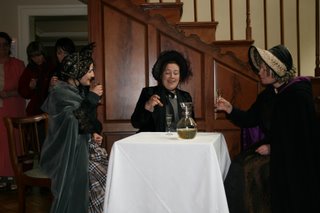
The guests boarded the coach after this for a tour of some of the sites included in the guide - down Spen Lane to St Mary's Church where Mary Taylor is buried, on to the Gomersal Lodge Hotel (formerly High Royd, Mary Taylor's home up to her death in 1893), past the site of Rawfold's Mill, on to Healds Hall, Liversedge (now a sumptuous hotel), past Ellen Nussey's early home Rydings (now situated next to a paint factory), past St Peter's Church in Birstall and back to Oakwell Hall.
Later, at the Gomersal Park Hotel, which is a greatly extended version of Ellen Nussey's Moor Lane House, some of the costumed characters welcomed guests to a literary lunch. The speaker was the well-known Yorkshire Television presenter Ian Clayton, who talked about language change in Yorkshire, his own background as a miner's son who went to grammar school and an occasion when he was shaking hands with the Archbishop of York when his mobile phone suddenly rang with the tune of 'Popeye the Sailor Man'. He read short extracts from several books including, of course, Shirley.
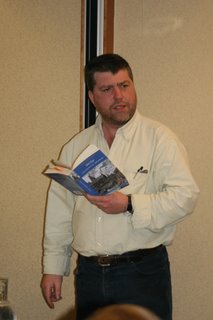
You can visit Kirklees Tourism by clicking on the link on the right. If you want a copy of the guide, contact Joanne Catlow at 01484 223803 (add +44, delete the initial 0 if you are not in the UK) or email her: joanne.catlow@kirklees.gov.uk
Say you heard about it from this blog.
Photocredits: Richard Wilcocks
On Friday 19 May Kirklees Community History and Kirklees Tourism launched the Shirley Country Guide. To be strictly accurate, they relaunched it in a splendid new colour version, because it has appeared in a shorter form before.
Shirley Country is the name generally accepted by both the Brontë Society and Kirklees Metropolitan Council as the name for the area of West Yorkshire crossed by the River Spen and the manically busy M62 motorway which contains such havens of leafy tranquillity as the Red House in Gomersal, Oakwell Hall in Birstall and St Peter's Church in Hartshead, an area well known to Charlotte Brontë, Ellen Nussey, Mary Taylor and many of the real-life characters who appeared with fictional names in Shirley.
Published in 1849, the novel caused quite a sensation. The local literate, gossiping classes had only just discovered that the quiet parson's daughter from Haworth was secretly the famous Currer Bell, the author of Jane Eyre. Now they found themselves and their neighbours appearing in her latest work.
Charlotte knew the area well from her schooldays in Mirfield and was a frequent visitor. When Charlottë's parents were first married they lived in Hightown, and her father was minister at Hartshead at the time of the Luddite riots of 1812.
The guide features information, directions to and a map of fourteen places which Charlotte knew. Visitors are invited to create their own literary trail.
Some locations have actually disappeared - Rawfold's Mill, for example, which once held out against hundreds of armed and masked Luddites - most of them skilled workers intent on smashing up the new machinery inside which had taken away their livelihoods. It is now a corner of a modern industrial estate.
Oakwell Hall, on the other hand, is thriving in its hundred acres of idyllic parkland rolling down to the edge of the M62, an Elizabethan manor house which contains many of the features of Fieldhead, as described by Charlotte in Shirley, with a visitors' centre nearby geared to the needs of school parties.
The launch started here. Several dozen guests - including representatives of the Brontë Society - watched Charlotte (played by Tania Gillmartin) and Ellen (Bridgid Harbour) arrive by horse-drawn carriage, to be met by the Mayor of Kirklees, Councillor Margaret Fearnley. Joanne Catlow as Shirley Keeldar confronted Chris Yates as the Curate Mr Donne as part of a dramatised extract from the novel performed in the dark-panelled main hall inside.

Charlotte and Ellen later travelled by horse-drawn carriage to Briarmains - Red House. The guests went by a more modern coach.

At Briarmains, Mary Taylor (Julie O'Connell) did the greeting, and snifters of madeira wine were available, to be consumed during the watching of more dramatisations: the three friends conversed, Ellen regaling the other two with a shocking story of bigamy involving a gentleman who secretly kept a lunatic wife in an upstairs room.
Then Robert Moore (John Bunker) walked through the front door - based on William Cartwright, whose mill at Rawfolds received the attention of the rioters. He talked with Hiram Yorke (Phil Knight) who was based on Mary's father Joshua Taylor.

The guests boarded the coach after this for a tour of some of the sites included in the guide - down Spen Lane to St Mary's Church where Mary Taylor is buried, on to the Gomersal Lodge Hotel (formerly High Royd, Mary Taylor's home up to her death in 1893), past the site of Rawfold's Mill, on to Healds Hall, Liversedge (now a sumptuous hotel), past Ellen Nussey's early home Rydings (now situated next to a paint factory), past St Peter's Church in Birstall and back to Oakwell Hall.
Later, at the Gomersal Park Hotel, which is a greatly extended version of Ellen Nussey's Moor Lane House, some of the costumed characters welcomed guests to a literary lunch. The speaker was the well-known Yorkshire Television presenter Ian Clayton, who talked about language change in Yorkshire, his own background as a miner's son who went to grammar school and an occasion when he was shaking hands with the Archbishop of York when his mobile phone suddenly rang with the tune of 'Popeye the Sailor Man'. He read short extracts from several books including, of course, Shirley.

You can visit Kirklees Tourism by clicking on the link on the right. If you want a copy of the guide, contact Joanne Catlow at 01484 223803 (add +44, delete the initial 0 if you are not in the UK) or email her: joanne.catlow@kirklees.gov.uk
Say you heard about it from this blog.
Photocredits: Richard Wilcocks
Thursday, 18 May 2006
Clare Boylan
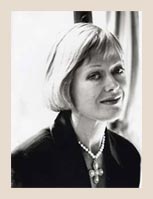
This obituary is from The Times online for 18 May:
Clare Boylan
April 21, 1948 - May 16, 2006
Irish author who achieved wide acclaim with Emma Brown, the completion of a two-chapter fragment by Charlotte Brontë
Clare Boylan never saw herself as purely an “Irish� writer, although she set several of her books in Dublin past and present. A sense of place is powerfully conveyed in all of them.
In one, Home Rule (1992), she convincingly portrayed the city in the turmoil of the 1890s and beyond as it came to grips with historic national and political issues. But her last novel, Emma Brown, published in 2003, was set mainly in London, and was Boylan’s interpretation and completion of a two-chapter fragment left behind by Charlotte Brontë.
This was perhaps her best book, as well as her most successful. It involved a huge amount of research, which included walking around the streets of London with a guide, until her feet blistered and bled.
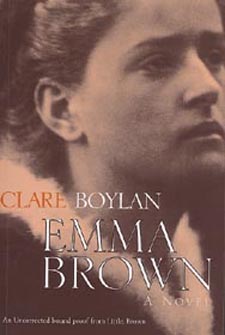
She was no stranger to this kind of painstaking research: it was the backbone of her award-winning journalism. She had won the 1974 Journalist of the Year title in Dublin as a young feature writer on the Evening Press. Her memorable series on homeless women involved spending many nights on the streets with them.
[......]
Boylan was always going to be a writer. In her contribution to A Portrait of the Artist as a Young Girl, a collection of childhood memories by nine Irish women writers, she recalled how her mother wrote children’s stories for herself and her two sisters, Ann and Patricia, as well as essays and short stories. It was the job of the seven-year-old Boylan to type out the articles with two fingers, as a reward for which she was taken to the cinema.Three decades later, a short film, Making Waves, based on her short story Some Ladies on a Tour, was nominated for an Oscar in 1988.
[.....]
Boylan wrote seven novels: Holy Pictures (1983); Last Resorts (1984); Black Baby (1988); Home Rule (1992); Room for a Single Lady (1997), which won the Spirit of Life award; Beloved Stranger (1999) and Emma Brown (2003). There were also three collections of short stories and two anthologies, The Agony and The Ego, The Art and Strategy of Fiction Writing Explained (1993) and The Literary Companion to Cats (1994).
She also wrote a great deal of literary criticism and a radio dramatisation of Molly Keane’s novel, Good Behaviour (2004).
Boylan was an able hostess. She never lost her interest in good food, and one of the joys of her later years was the house she kept in Brittany where the daily ritual of buying and cooking was taken as seriously by the locals as by Boylan. One of her favourite cities was Venice, which she visited many times, often out of season, glorying in the winter light and the emptiness of St Mark’s Square in January.
Boylan was a member of Aosdána, the affiliation of artists established by the Arts Council of Ireland to honour those who had made an outstanding contribution to the arts.
She was a compassionate, but not an overly sentimental, animal lover, with an interest in promoting more humane farming and husbandry techniques.
Students on her creative writing course thought her a brilliant and generous teacher. As a writer she was never content to stand still or produce work that was as only as good as her previous output. Culminating in the extraordinary Emma Brown, each of her books was arguably better than the one before it, as well as significantly different.
Boylan had battled cancer for some time. One friend, upon learning of her final illness, said: “Part of the tragedy is that there will be no more wonderful books.�
Clare Boylan is survived by her husband, Alan Wilkes.
Clare Boylan, author, was born on April 21, 1948. She died on May 16, 2006, aged 58.
Monday, 15 May 2006
Bronte Society Spring Walk
It happened on Sunday 14 May.
It started at St Peter's Church in Birstall and ended at Rydings, once the home of Ellen Nussey. Margaret Berry, the walk leader, explained just about everything that needed to be explained, and participants went home tired, happy and slightly damp.
The weather was of the Pennine variety - grey and showery. Nobody minded.
The full itinerary can be found in the blog archive for February. A longer account will appear in the next Gazette, which comes out in September.
Meanwhile, here are some pictures:

Miss Wooler's grave, St Peter's churchyard, Birstall

Outside Oakwell Hall

Front
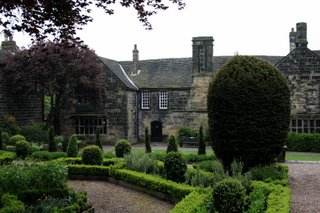
Back
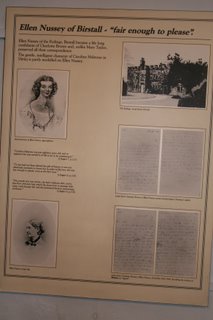
One of the displays inside.
It started at St Peter's Church in Birstall and ended at Rydings, once the home of Ellen Nussey. Margaret Berry, the walk leader, explained just about everything that needed to be explained, and participants went home tired, happy and slightly damp.
The weather was of the Pennine variety - grey and showery. Nobody minded.
The full itinerary can be found in the blog archive for February. A longer account will appear in the next Gazette, which comes out in September.
Meanwhile, here are some pictures:

Miss Wooler's grave, St Peter's churchyard, Birstall

Outside Oakwell Hall

Front

Back

One of the displays inside.
Vote for the little book

One of the earliest known books written by one of the Brontë sisters will feature in a BBC2 programme which has gathered together some of the most quirky and unusual museum items from across the UK to create an online 'People’s Museum' voted for by the general public.
The programme, designed to coincide with Museums and Galleries Month, will feature Charlotte Brontë’s ‘little book’ of writings which makes up part of the Museum collection at the Parsonage. The People’s Museum programme will invite viewers to vote on their favourite museum artefact featured in the twenty-part series which will go out on BBC2 at 3.30pm five days a week - commencing on 15 May 2006.
Charlotte's little book will be featured on 30 May. The object with the most votes will be proclaimed the winner on 9 June 2006, although featured objects will have a place in a virtual museum on the BBC’s history website.
Competition was fierce for inclusion in the programme as the producers, Reef TV, struggled through the enormous pile of entries from around Britain. The Parsonage is delighted to have been chosen and hopes that Brontë fans across the UK and from overseas will register their affection for the Brontës by voting on the day.
The tiny book, no bigger than the palm of a hand and measuring 42 x 64 mm, was believed to have been written by Charlotte between 1826 and 1829 when she was aged between 10 and 13, for her sister Anne. The book, bound in leather at a later date, is in immaculate condition and includes beautiful watercolour pictures and the original covers, which were made from tiny pieces of grey-flowered wallpaper.
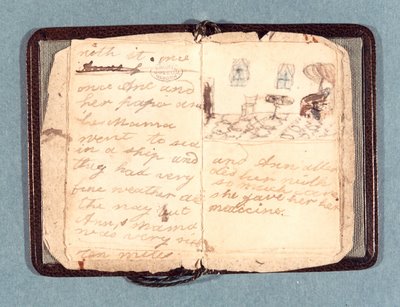
Filming took place at the Parsonage earlier in the year with presenter Jules Hudson interviewing Librarian Ann Dinsdale, who explained to viewers the origin of the tiny book: how it was made, what it was made of and more importantly how Charlotte’s early writings influenced her most famous works:
"This little book is the earliest surviving manuscript by Charlotte Brontë and marks the beginning of her long apprenticeship in literature. It was an apprenticeship that would culminate twenty years later with the writing of Jane Eyre - one of the most popular books ever written.�
The presenter, Jules Hudson, is an historian and archaeologist who has presented Channel 4’s Time Team and the BBC’s Horizon programmes. He was fascinated by the little book whose writing is hardly readable. It is now rather fragile and delicate. Visitors to the Museum will be able to see the book on display at the Parsonage from June 2006.
This post is by Diane Benn
Further notes about the 'little book':
The Brontë sisters are famous for their literary works, including Jane Eyre and Wuthering Heights; however their interest in writing had begun many years before during their childhood.
The siblings conjured up plays and imaginative stories, inspired by a set of toy soldiers given to Branwell by Mr Brontë in 1826. The children each named the soldiers after famous heroes of the time such as the Duke of Wellington and Napoleon, and from these toys they created their imaginary worlds and stories about Gondal and Angria now known as Brontë Juvenilia. From this period onwards the Brontë children produced ‘little books,’ written in tiny writing and supposedly created small enough for the toy soldiers to read.
It is also believed that many years of writing these ‘little books’ could have contributed to Charlotte’s degenerative eyesight. The minuscule script can be seen as part of a secret imaginary world that was shared between the siblings and hidden from prying adult eyes.
This ‘little book’ originally belonged to Arthur Bell Nicholls, the husband of Charlotte Brontë. After his death most of his Brontë collection was sold in an auction in 1907. Unfortunately for the Brontë Society at the time the ‘little book’ was sold to a private American collector called Henry H. Bonnell. It resided with him until his death in 1926, finally ‘returning home’ in 1927 when it was kindly donated by Henry Bonnell’s family to the Parsonage, the place where it was written.
Please see the Brontë website for further details - use the link on the right.
Sunday, 14 May 2006
Anna in Haworth
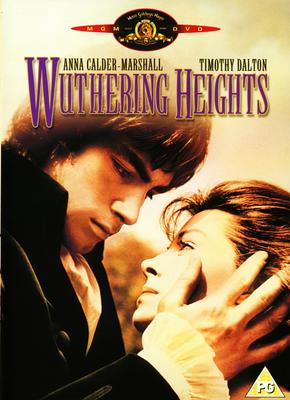
This is a reminder that Anna Calder-Marshall, Cathy with Timothy Dalton's Heathcliff in the much-loved 1970 version of Wuthering Heights, is to make an appearance on the Friday evening ( 2 June 2006) of the annual Brontë Society June weekend in Haworth.
She will be acting in Charlotte, Emily and Anne, a moving play by Douglas Verrall. Anna is part of an ensemble of five women who each play a family member and other parts. Other cast members are Helen Ayres, Yvonne Bonnamy, Christine King and Catherine Harvey.
The play is directed by Valerie Doulton, who launched her Live Literature Company in 2003.
Wednesday, 10 May 2006
Visiting Italy?
Member of the Brontë Society?
The Italian Section cordially invites you to get in touch before you go.
Email: info@bronteitalia.it
The Italian Section cordially invites you to get in touch before you go.
Email: info@bronteitalia.it
Monday, 8 May 2006
Bronte Boats

The Verdopolis leaves a lock in the picture above.
Tourists visiting the Parsonage can now sample the beauties of Yorkshire’s waterways thanks to a new initiative between the Museum and Brontë Boats based at the newly refurbished Hebden Bridge Marina.
The partnership will offer visitors the chance to take a one-hour canal trip with an all-inclusive ticket of £12.00. The price includes return canal cruise and entry to the Parsonage.
Brontë Parsonage Museum Director, Alan Bentley said, “We are delighted to announce the new initiative with Brontë Boats. The visitor experience will be greatly enhanced with the addition of the canal cruise which gives tourists the chance to relax on board whilst taking in some of the wonderful countryside that the Brontës wrote about and experienced for themselves."
Brontë Boats launched its new 53 passenger canal cruiser Verdopolis to cater for the increasing number of visitors to the area. Passengers also have the option to book private parties for their guests who can tuck into a three course carvery meal, Indian, Greek or buffet food and listen to music of their choice. The boat has a bar, conference facilities and toilets.

For further information about Brontë Boats canal cruises please telephone 01422 845557 or email Sharon.bronteboats@virgin.net. The Brontë Boats website can be found at www.bronteboats.co.uk. Address is - The Marina, New Road, Hebden Bridge, West Yorkshire, HX7 8AD
For further information on events and exhibitions at the Brontë Parsonage Museum please telephone 01535 642323 or visit the link on the right.
Posted by Diane Benn
Wednesday, 19 April 2006
Latest from the BBC

A BBC Press Release:
Jane Eyre by Charlotte Bronte - a new drama adaptation for BBC ONE
Category: TV Drama; BBC ONE
Date: 18.04.2006
Printable version
Newcomer Ruth Wilson (Jane Eyre) and Toby Stephens (Edward Rochester) head up an all-star cast in a passionate new version of the much-adored classic Jane Eyre for BBC ONE.
The four-part serial also stars Francesca Annis as Lady Ingram, Christina Cole as Blanche Ingram, Lorraine Ashbourne as Mrs Fairfax, Pam Ferris as Grace Poole and Tara Fitzgerald as Mrs Reed.
Georgie Henley, who recently starred in the Christmas blockbuster The Chronicles of Narnia plays young Jane while Aidan McArdle plays the visionary John Eshton. The drama is currently filming entirely on location in Derbyshire.
Jane Tranter, BBC Controller of Drama Commissioning says: "Sandy Welch's wonderful version of Jane Eyre for BBC ONE will add that special ingredient to the mix of dramas due for transmission this autumn, which includes the new series of Robin Hood; Lizzie Mickery and Dan Percival's conspiracy thriller, State Within; Sally Wainwright's heart-warming series The Amazing Mrs Pritchard plus Russell T Davies's Torchwood for BBC THREE."
The sustainability and appeal of Jane Eyre lies in her universality and the audience's appetite for a well-told romantic tale.
Orphaned at a young age, Jane (Ruth Wilson) is placed with her wealthy aunt Mrs Reed (Tara Fitzgerald) who neglects Jane in favour of her own three spoiled children.
Mrs Reed's spitefulness leads her to withhold news that could change Jane's life for the better.
Instead she brands her a liar and sends Jane to Lowood School where she remains until the age of 19.
When she finally leaves the dark memories of Lowood behind, she embarks on a career as a governess and her first position is at Thornfield Hall, the home of the alluring and unpredictable Edward Rochester.
Jane's journey into the world and as a woman begins.
Producer Diederick Santer adds: "In her brand new adaptation of Jane Eyre, Sandy Welch has mined Bronte's novel for every ounce of passion, drama, colour, madness and horror available, bringing to life Jane's inner world with beauty, humour and at times great sadness.
"The locations we have chosen are stormy and majestic and I hope that Sandy's original take on the story will be enjoyed as much by long-term fans of the book as by those who have never read it."
Filming is underway until June at the historical medieval castle Haddon Hall, owned by Lord Edward Manners, and other locations across Derbyshire.
Jane Eyre is adapted by Sandy Welch (North and South, Magnificent Seven), directed by Susanna White (Bleak House) and the Executive Producer is Phillippa Giles.
Muriel Spark

Muriel Spark, aged 88, died on 14 April 2006 in hospital in Florence, Italy. Her funeral was held on 15th April in the church of Oliveto, a suburb of Civitella della Chiana, a delightful little place in Tuscany where she had been living for 26 years.
In September 2005 Muriel Spark had received the honorary Citizenship and the keys of the Town.
With her novel Invidia (Envy), published by Adelphi, she won the 2005 edition of the Literary Prize Isola d'Elba. In the photo we see her while receiving the prize from the Italian actress Maria Grazia Cucinotta.
Posted by Maddalena de Leo
Dame Muriel's first novel was published in 1957 but it was the 1962 classic, The Prime of Miss Jean Brodie, that brought her to the public’s attention following good reviews from critics.
The book was turned into a movie starring Dame Maggie Smith, bringing her a best actress Oscar in 1969.
In the course of her career Dame Muriel wrote over 20 books, which included not only novels but also critical studies of Mary Shelley and Emily Brontë.
Thursday, 13 April 2006
Talli's Secret
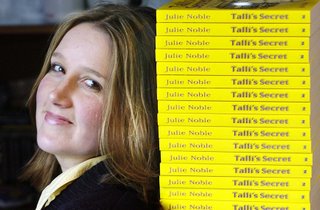
Brontë Society Gazette is the news magazine of the Brontë Society. It is sent to members three times a year, and is not to be confused with Brontë Studies, which is an academic journal - see the link on the right.
Below is a book review from the most recent issue, which follows on from an article in the January issue by the book’s author, Julie Noble (pictured above), entitled Was Maria dyspraxic?
Please contact the blog (email address on the right) if you wish to make a comment.
Talli's Secret
A psychotherapist’s view
Talli's Secret or Cassie's story by Julie Noble is dedicated to 'all who know what it is to struggle' It is inspired by children who have lots to contribute and express but for whom the school system, with its structures and emphasis on the written word, thwarts and disables.
Julie Noble's own son, like my own, has struggled this way. The inspiration for the book came when studying Jane Eyre and learning that Helen Burns was based on Charlotte's eldest sister Maria, and that Helen was arguably literature's first dyspraxic.
Cassie's class are studying the Brontes. Like Helen Burns at Lowood, Cassie struggles at school and is berated by her teacher. She is misunderstood as defiant and mocking. Mrs Harrison uses 'hardened' and 'slatternly', the same words that Helen's teacher uses on her.
The life-threatening physical conditions which Charlotte Bronte fictionalised in Jane Eyre are unimaginable to Cassie but we discover that the misery and frustration experienced by Cassie is uncannily similar to that of Helen.
What stood out for me over and above the struggle of children with dyspraxia or dyslexia is the magic of creativity and the therapeutic value of story telling..
Charlotte Brontë saw that children can feel but can't analyse their feelings. As a Psychotherapist I would say that children need relational experiences with those close to them to express and process their feelings and to develop a sense of themselves and their life story that matures and develops with them.
Talli's Secret is a wonderful account of how trauma and loss can rupture the coherence and meaning of individual stories. Better still it goes on to describe a process of transformation and the bringing together of those involved, their individual and overlapping stories to replace brokenness and despair with hope.
Cassie survived the road accident which killed her sister Lizzie and disabled her father. The family is stuck, barely living, futilely going through the motions of daily life. There is a heaviness and poignancy about her parents' mutual estrangement. Their communication is as tight as the matchstick house her father labours over. They have no space in themselves for Cassie and her difficulties. Cassie is in a daze, preoccupied but unable to bring into focus the impressions that fuel her silent vigil.
A school trip to the Parsonage sets her off working it all out. But not on her own. She makes two new friends, a new girl at school and Talli (Charlotte Brontë) who both become important in sharing and witnessing her experience.
I found the encounters with Talli confusing but the message is clear. Cassie's experience is recognised by Talli. They share the loss of their sisters and Cassie learns that Maria, 'the most talented of us all' had struggled at school like her.
Talli encourages Cassie to talk about her dead sister Lizzie. Cassie asks what Talli did with her grief. The secret is Scribblemania, the compulsion to write. Talli/Charlotte had put Maria into Jane Eyre. Writing works for Charlotte as a way of making something of the unbearable.
Cassie discovers the delights of reading and steams through Jane Eyre. Later, when asked to explain the mess she's in with her teacher and the bullying school girl Savannah; Cassie remembers Miss Temple's imperative to Jane, to tell her story, to add and exaggerate nothing. She tells it and everything starts to shift. The teacher understands.
Her homework that weekend is making books as the Brontes did. Cassie can't wait. She finds words 'whispering in her brain', and her fingers itching to write them. She writes her book 'Talli's Secret'. The parents are approached and awoken, unwillingly at first, out of their deadly retreat. Cassie frees herself and becomes a catalyst for change in those around her, her family, her teachers and her bully.
The book holds several paradoxes for me. We have in Cassie the learning difficulties dyspraxia and dyslexia and the emotional befuddlement associated with trauma and loss which can make learning difficult.
Did Cassie have these problems before? If so, she would be likely to need more than understanding and inspiration to take to the written word with fluency.
The book, like Cassie, has rather too much going on. There is a lot to hold on to and digest as I read it and a lot I'm puzzled about. Having said that I could also say that this is a book with a lot going on of which there is much to mull over. The readers that engage with it will find it a meaty read, others might find it confusing and a bit much.
Sally Rose.
Talli’s Secret, recently long-listed for the Whitbread Book Awards, is available from the Parsonage shop - please use the link on the top right.
Subscribe to:
Comments (Atom)